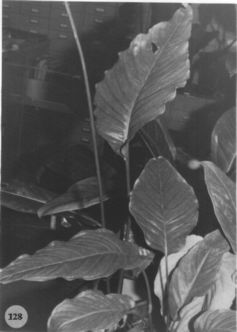




Oesterr. Bot. Z. 8: 180. 1858. TYPE: Costa Rica, near Naranjo, Oersted s.n. (W, destroyed?; Photo of Schott Aroid Drawing #228, NYUG Neg. #N.S. 3817).
Terrestrial; stems short, to 2 cm diam.; roots numerous, short, tan; cataphylls 7-12 cm long, moderately thin, apiculate at apex, drying brown, persisting intact, ultimately deciduous.
LEAVES usually ± erect; petioles ± quadrangular, (12)30-65 cm long, ca. 0.6 cm wide; the geniculum 1.5-2 cm long, remote from base of blade 10-20 cm; blades ovate to narrowly ovate or lanceolate-elliptic, moderately thin, 20-66 cm long, 8.5-30 cm wide, caudate-acuminate at apex, obtuse to truncate, sometimes rounded to subcordate at base, abruptly decurrent on petiole; both surfaces semiglossy; midrib convexly raised above, raised and obscurely ribbed below; primary lateral veins 11-20 per side, raised in valleys above, raised below; lesser veins sunken above, obscure below; collective vein arising from one of the lowermost primary lateral veins, 2-8 mm from the margin, sunken above, raised below.
INFLORESCENCE erect, longer than leaves; peduncle (30)70-130 cm long; spathe ovate-lanceolate, pale green, 8-13 cm long, 2.5-4.8 cm wide, acuminate at apex, rounded at base; spadix pale green, 5-12 cm long, ca. 9 mm diam. at base, ca. 6 mm diam. at apex; flowers sub-rhombic to 4-lobed, 2.2-2.5 mm long, 2.2-2.7 mm wide, the sides parallel to spirals usually straight, those perpendicular to spirals sigmoid; 8-9 flowers visible in the principal spiral, 12-18 flowers visible in the alternate spiral; tepals matte, minutely and densely papillate, lateral tepals 1.4-1.8 mm long, the inner margin straight; pistils weakly emergent, green; stigma brushlike and weakly exserted, glistening for 3 or 4 days before stamens emerge; stamens emerging in a scattered manner on fleshy, greenish, translucent filaments, lateral stamens emerged throughout before alternates appear, held at sides of pistil; anthers creamy white, 0.7-1 mm long, 1-1.2 mm wide; thecae ellipsoid, mounded with abundant, creamy white pollen.
INFRUCTESCENCE not seen. Fig. 128.
Anthurium oerstedianum is endemic to Costa Rica at elevations of 900 to 1,300 m, principally from the Pacific slope in the southwcst in premontane wet, tropical wet, and premontane rain forest. Anthurium oerstedianum is distinguished by its strictly terrestrial habit as an understory forest herb and by its geniculum which is located 10-20 cm below the base of the blade. Other distinguishing features are its 4-sided petiole and its greenish spadix. The species is a member of section Pachyneurium despite its somewhat atypical elongate petioles, its remote geniculum, and lack of a densely rosulate habit. Anthurium cuspidifolium, which is synonymous with A. oerstedianum, was reported by MacBride (1936) from Peru. However, the specimens cited by him [MacBride 5622 (F); Schunke 572 (F)] are referable to A. flavescens Poepp.
 |
Map of Mesoamerican specimens with coordinates
Costa Rica Puntarenas: Las Cruces Botanical Garden, 1300 m,, 11 Jan
1978, Thomas B. Croat 44415 (MO).
Costa Rica Puntarenas: 1330 m,, 22 March 1967, Raven 20922 (MO).
Costa Rica Puntarenas: Osa Península,, 1968, Gilbert s.n. (MO).
Costa Rica Puntarenas: 150-650 m, 08.27N 83.33W - 08.30N 83.38W, 22
May 1988, C. Kernan & P. Phillips 500 (MO).
Costa Rica Puntarenas: Fila Costeña, 950-1150 m, 08.49.18N 83.11.15W,
10 December 1993, Michael Grayum 10652 (CR, MO).
Costa Rica San José: 800 m, 09.44N 84.23W, 1 January 1985, Michael
Grayum & Mel Baker 4693 (MO).
Costa Rica San José: 1000 m,, 22 May 1976, Thomas B. Croat 35267 (MO,
NY).
Costa Rica San José: 900 m,, 22 May 1976, Thomas B. Croat 35293 (MO).
Costa Rica San José: Río Chirripó del Pacífico,
1000 m,, 30 Dec 1969, Burger & Liesner 7124 (MO)
. Costa Rica San José: 900 m,, 14 Aug. 1977, Thomas B. Croat 43419
(MO). Costa Rica San José: 1010 m,, Dec. 1935, Skutch 2291 (MO).
Costa Rica San José: 1200-1300 m, 09.26.30N 83.43.00W, 19 August 1990,
Michael Grayum, Helen Kennedy & Noriaki Murakami 9951 (MO).
Costa Rica San José: Reserva Biologica Carara, 500 m, 9.46.10N 84.33.50W,
27 September 1990, Helen Kennedy, Quírico Jiménez & Rodolfo
Zúñiga 4687 (CR, MO).
Costa Rica San José: Z.P. La Cangreja; Cerros de Puriscal, 800 m, 09.44.12N
84.23.28W, 20 Nov 1993, J.F. Morales 2041 (CR).
Costa Rica San José: Z.P. La Cangreja; Cerros de Puriscal, 400 m, 09.42.50N
84.23.30W, 8 May 1993, J.F. Morales 1443 (CR).
Costa Rica San José: 990-1100 m, 09.18.24N 83.46.11W, 9 September 1996,
Thomas B. Croat & Dylan Hannon 79111 (MO, WU).
Costa Rica San José: ca. 580 m, 09.41.30N 84.14W, 28 January 1997,
M. H. Grayum, B. Hammel & F. Morales 11179 (CR, INB, MO)
Costa Rica San José: 1200 - 1300 m, 09.48.05N 084.27.52W, 5 Jan. 1996,
Hammel et al. 20071 (MO).
Costa Rica San José: 1200, 9.48.05N 84.27.52W, 5 ENE 1996, Barry Hammel
20071 (INB).